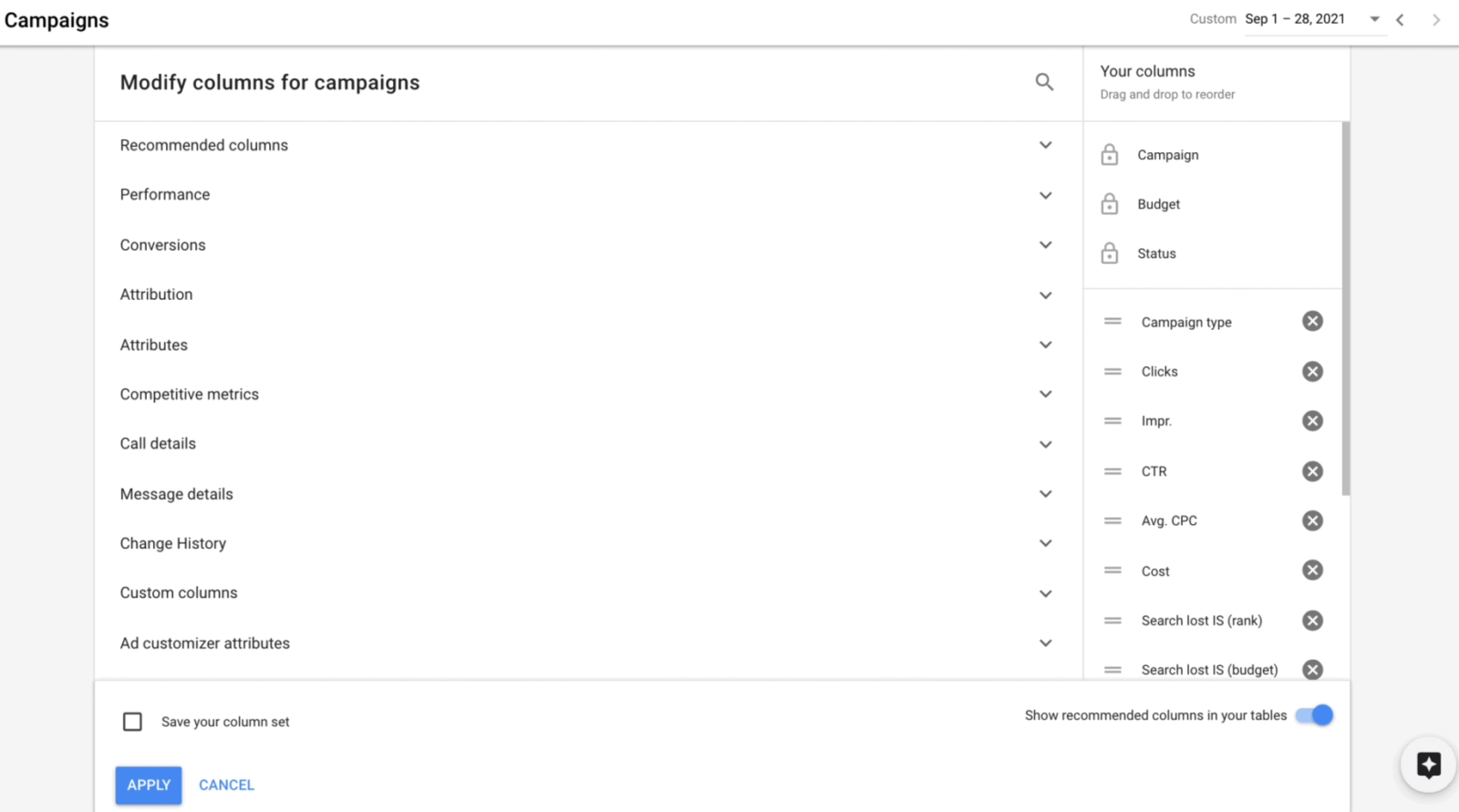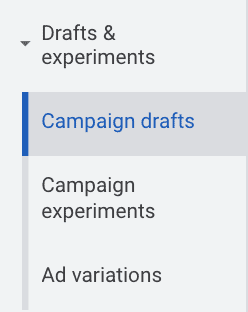In this article, you will learn how to optimise Google Ads campaigns after launch and which key figures you need to pay attention to. With this guide, you will be able to optimise your own Google Ads campaigns.
Setting up a Google Ads campaign once is not enough to ensure the long-term success of your ads. Only by continuously optimising a Google Ads campaign will you be able to place Google Ads profitably and successfully. You can find out how to set up your first Google Ads campaign in our article “Google Ads guide: How to master your first ad campaign in no time“. In this article, I will explain how to optimise your Google Ads campaign based on this.
Optimise Google Ads: Relevant key figures
The first step is to understand which metrics are really relevant for optimising Google Ads. The standard metrics in your account are not very meaningful. You must first activate the important metrics in your views. Here is a brief guide on how to do this:

You can view the displayed key figures under “Columns”. Then go to “Customise columns” and you will see a list of all possible key figures.

Essential key figures
First of all, here are the basic metrics you should look at to optimise your Google Ads campaigns:
- Impressions: How often were your adverts played?
- Clicks: How often were your adverts clicked on?
- CTR (click-through rate): The CTR is calculated by dividing the clicks by the impressions.
- Average CPC (Costs Per Click): What is the average click price?
- Costs: What costs were incurred in the period under review?
These key figures are important, but are not enough to optimise Google Ads. A few words about CPC: Many agencies and freelancers still pay a lot of attention to CPC. Especially in times of smart bidding and automation, this is no longer up to date. An increased/high CPC is not necessarily negative. A high CPC can, for example, be an indication of a valuable keyword that converts particularly well and therefore has high competition.
With smart bidding – for example “maximise conversions” – Google also adjusts the bids so that the bid is increased if there is a high conversion probability. This means that high CPCs alone are of little significance.
Conversion key figures
Ultimately, optimisations should always be decided on the basis of conversion data.
If you’re wondering what a conversion is, here’s a quick explanation: A conversion is a target action that a user performs on a website. This can be, for example, filling out a contact form or making a purchase in an online shop. Ultimately, the goal of a company is to generate sales – and conversions measure precisely this business success. In the case of service companies, such as tax consultants, there is no direct sale on the website, which is why a conversion can be a submitted contact form or a booked consultation appointment. In an online shop, success is of course easier and more directly measurable.
Upselling, cross-selling & measuring success
Discover how to effectively measure and boost cross-selling opportunities with actionable strategies tailored for agencies and freelancers on the Raidboxes blog.
Back to the key figures. CTR and CPC are also important key figures and an improvement in the figures can also indicate an improvement in the campaigns. However, a good CTR is not enough. Ultimately, the goal is to generate conversions. For this reason, the following conversion KPIs are particularly important:
- Conversion: How many conversions were generated? Only the total number of conversions is displayed here.
- Conversion rate: Is calculated by dividing the conversions by the clicks. Gives an indication of how “well” a keyword converts. A keyword that indicates an intention to buy will naturally generate more purchases than an informal keyword.
- Cost per conversion: This is calculated by dividing the conversions by the costs. The cost per conversion provides a good indication of how budgets should be allocated. For example, if a campaign generates conversions at a more favourable price because the keywords are particularly relevant, it makes sense to invest more budget in these campaigns.
The following key figures are also relevant for online shops or companies that can measure sales directly:
- Conversion value: What turnover was generated by the Google Ads campaigns.
- Conversion value/costs: This key figure is a kind of ROI (return on investment). It therefore provides information about the relationship between your revenue and your costs. The revenue should of course be greater than the costs.
- Conversion value/click: This is a key figure that can justify a high click price. If the average click price is €10 but the revenue per click is €50, the click price of €10 is still profitable. This explains why the CPC alone is not very meaningful.
Subscribe to the Raidboxes newsletter!
We share the latest WordPress insights, business tips, and more with you once a month.
"*" indicates required fields
Other important key figures
There are also other important key figures that can help with optimisation decisions. The following three key figures provide information on whether the budget needs to be increased or whether the adverts or landing page need to be improved:
- Share of possible impressions: Can more clicks be produced here or has the maximum potential already been exhausted? Important to remember: In Google Ads search campaigns, adverts are only shown to customers who enter certain search terms. If this value is 100 per cent, the ads cannot be displayed more frequently. In this case, increasing the budget is useless.
- Percentage of impressions lost in the search network (ad rank): This shows the percentage of all possible impressions lost due to a low ad rank. The ad rank is determined by the quality factor and the maximum bid. The quality factor is determined by the ad relevance, the landing page relevance and the CTR. If this lost share is too high, you can either increase the maximum CPC or the quality factor. If you increase the maximum CPC in response, the budget will probably be the limiting factor. Important! If you use Smart Bidding, such as “Maximise Conversions”, the bid is automatically determined by the system.
- Percentage of lost impressions in the search network (budget): This shows the percentage of all possible impressions lost due to insufficient budget. If this value is high, you should increase the budget to get more impressions.
These are the most important Google Ads metrics that you should consider when analysing your campaigns, ad groups, keywords, ads, etc.
Continuous optimisation
Now you know the most important key figures that give you information about your campaigns. Next, I would like to explain how you can ultimately optimise your Google Ads.
Important: If you work with Smart Bidding, you do not have to make the manual adjustments described below. So if you maximise conversions, use target CPA or target ROAS and have enough conversion data available for Google, Google will optimise your Google Ads automatically based on data. Most of the time should then be spent on optimising the landing page.
Optimisation based on data
If you work with bidding strategies such as: Maximise clicks or manual CPC, then Google will not automatically adjust your bids for conversions. This can be the case if you have too little conversion data or a low budget. In this case, you will have to make adjustments yourself.
The only reliable key figures are conversion data, as described above. Optimisation decisions should be made on the basis of the above-mentioned key figures. Optimisation can take place at various levels:
- Campaign level: Which campaigns work particularly well and produce many conversions? Which campaigns should receive a budget increase because the costs per conversion are particularly low or the conversion value is particularly high?
- Ad group: Which ad groups/groups of keywords work particularly well?
- Keywords: Which keywords convert particularly well? What are the costs per conversion? Should keywords be switched off?
- Adverts: Which adverts convert particularly well? Why might these adverts convert well? Do other adverts need to be adapted?
- Devices: Which devices work well? Does “desktop” perhaps convert better because visitors are more likely to fill out a lead form at their desk/workstation? Perhaps smartphone traffic converts less well. Perhaps the costs per conversion are also more favourable on smartphones? If your target group is B2B, you can exclude mobile devices, for example.
- Locations: For local companies in particular, it is important to know whether users in the immediate vicinity of the company location convert better than those who are a little further away. You can then adjust your bids accordingly.
- Target groups: Which target groups convert well?
- Advertising time planner: At what time of day, on which day of the week do adverts convert best?
- Demographic characteristics: Which age or gender converts better?
It is important that decisions can only be made on the basis of sufficient data. If a campaign only has a few conversions within a month, it is difficult to decide which keywords convert well, as the conversions may have occurred by chance.
If you have too few conversions, you can create “indirect conversions” – for example, the time spent on the landing page or the number of pages visited. Users who spend more time on the page or look at several pages are more valuable than those who leave the landing page directly. In this way, more conversion data can be generated to make better decisions. For example, for accounts with a small budget and few monthly conversions, you should take advantage of this.
Testing
Here’s a great tip for checking an improvement in performance: Campaign tests! When optimising my clients’ accounts, I always use this function to show that my optimisations have improved Google Ads performance.

Campaign tests work like this: You can create a modified version of a campaign under the menu item Campaign drafts. For example, you can define different campaign settings or select different keywords in a draft. You can then define a campaign test from this draft. The test can then be set for a certain period of time. I use at least 30 days as standard. For smaller accounts with less advertising budget, I recommend 60 or 90 days to collect sufficient data. The budget can then be allocated 50 percent to the original campaign and 50 percent to the optimised test campaign.
Why is this function so important? Of course, changes could also simply be made directly in the campaign and the change observed over time. However, the data is then not as meaningful. For example, data can be less meaningful because external factors generally influence campaign performance. For example, B2B campaigns may convert less well during the holiday season. In a campaign test, the overall campaign performance can drop, but I can use the 50%-50% test to show exactly that my test still performed better than the original. External factors therefore play no role.
Optimisation of the landing page
Although this article is about Google Ads, the topic of landing page optimisation is also super important for success and conversions, which is why I would like to look at this area separately. Ultimately, you buy traffic from Google for your landing page. However, this landing page must convert in order for you to see results. A poor landing page ultimately means that your Google Ads will also perform worse. Even the best Google Ads Manager can’t change that!
Find out more about optimizing your landing page
For help on what to look out for in general when creating landing pages, check out our post “10 tips for more conversions”. You can find out how to optimize SEA landing pages in the post “6 success factors for SEA landing pages”.
Many companies have false expectations of Google Ads or traffic sources in general. Google Ads is not a miracle cure and is only one source of traffic. A visitor can always be directed to a landing page, but without a landing page with a high conversion rate, the traffic is worthless. Many companies believe that advertising will solve their lack of leads. That’s why it’s important that you don’t make this mistake. Your landing page is super important for your success.
To illustrate this point, I would like to give you an example. Imagine two companies that both run Google Ads. Both companies optimise their Google Ads and have exactly the same campaigns, same structure, same keywords, same ads. Ultimately, the company with the better landing page wins.
Content marketing for advanced users: The 6 most important levers
Discover how to optimize your content marketing to reach the right audience, build trust, and achieve long-term success.
Here is a quote from Dan Kennedy: “The winner is not the business that gets the cheapest leads. The winner is the business that can afford to pay the most per lead.” In this context, this is the company with the better conversion rate and the greatest customer lifetime value. This business can buy clicks at a higher price and remain profitable at the same time.
Here is a simple calculation example:
A conversion rate of one per cent means that I need 100 clicks to achieve a conversion (1 % conversion rate = 1/100). A conversion rate of two per cent means that only 50 clicks are needed for a conversion (2/100 = 1/50). This means that with the same profit margin, a company with a 2% conversion rate can spend twice as much per click, as only half as many clicks are required.
If you have implemented the above points for optimising your campaigns and are still not seeing the results you want to see: Invest your time in optimising your landing page!
Conclusion
Hopefully, this article has taught you how to optimise your or your customers’ Google Ads campaigns. Remember that, ideally, you should always make decisions based on conversion data. Otherwise, you will have to rely on secondary metrics such as CTR and CPC and the presumed purchase intent.
Your questions about optimizing Google Ads
What questions do you have about optimizing Google Ads campaigns? We look forward to your comments. For more insights on WordPress, web design or online business, follow Raidboxes on Facebook or LinkedIn – or subscribe to our newsletter.


Leave a Reply